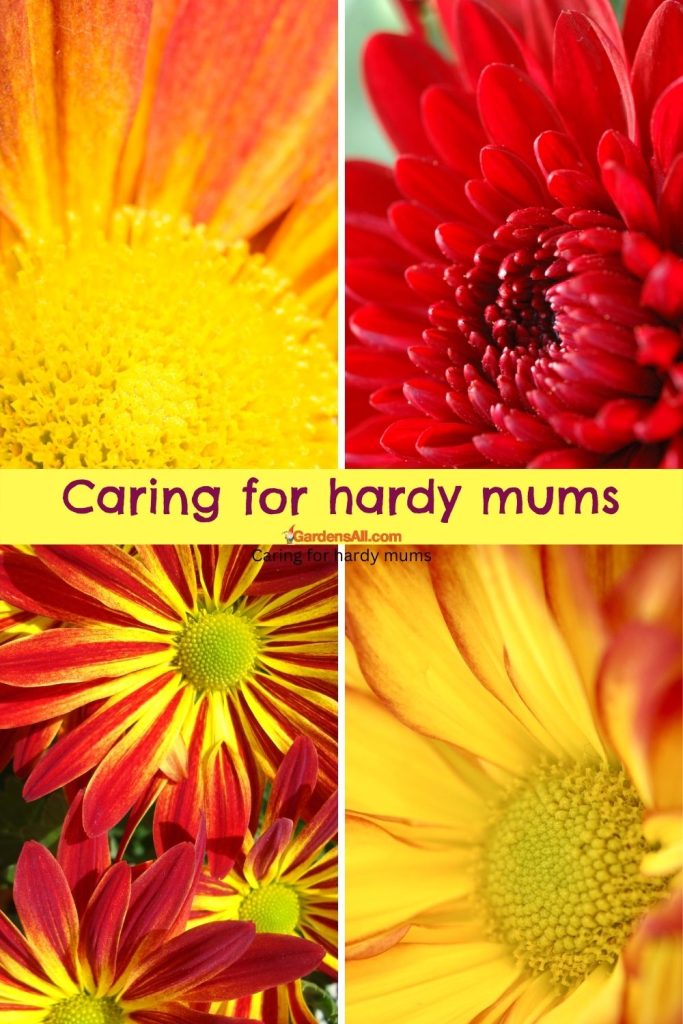Do you know how to care for hardy mums? And what is the difference in hardy mums versus regular mums. We went to our favorite local nursery and asked a few questions.
Hardy Mums Vs. Non-Hardy Mums
What’s the difference between a hardy mum and a non-hardy mum? Both go by the scientific name of Chrysanthemum morifolium, and both tend to have varieties that look alike. The main difference is literally how cold hardy they are.

Hardy Mums, Zones 4-9
A member of the Aster family, Hardy mums, are also known as garden mums and are hardy perennials in zones 4-9.
Non-Hardy Mums, Hardiness Zones 7-9
The non-hardy mums are known as florist mums, and tend to be grown in pots and aren’t as cold-hardy, and so aren’t typically perennial in most growing zones.
How to Care for Hardy Mums
Mums Blossoms
What Causes Mums to Bloom Early?
Early blooms may mean that the mums are not getting enough fertilizer and can lead to early blooms but thinner leafing and fewer buds. So if your mums are blooming early but sparsely, consider adding fertilizer.
Ideal Stage to Buy Mums and How to Choose Mums by the Blossoms
When selecting mums to buy, choose plants that are beginning to blossom but are only partially blooming. Unless you need fully blooming plants for an event, it’s best to avoid mums that are completely in full bloom because they’ll be waning in performance, longevity and appearance.
How Long Do Hardy Mums Bloom
Mum flowers provide long-lasting blossoms that can last from 4-8 weeks of vivid color.
Deadheading Mums
As blossoms brown with age, you can keep your mum plants looking beautiful and fresh by deadheading the blossoms.
When to Plant Hardy Mums in the Ground
Judy of Mitchell Nursery in King, North Carolina says she likes to plant the potted mums in fall after the blooms are spent. Once the leaves die back in winter, mulch them really well, then in spring once you see the new growth coming out, you can prune off any old remnants.
Fertilizer for Mums
Fertilize mums with nitrogen in spring as leaves and branches form but before the flowers form buds in late summer or early fall.
Judy uses Osmocote fertilizer and says to apply it in early spring, then again in about three months in July. These are general guidelines to let you know when to plan for fertilizing your mums. Beyond that, it’s usually best to follow the directions on the individual fertilizers.
Mulching Mums for Fall and Wintery
Once the mums stop blooming and you’ve deadheaded the flowers, the leaves will die back on their own as cold weather settles in. Then you can tuck them in for a long winter’s nap with a thick bed of winter mulch.

Sun for Mums – Full Sun or Partial Shade?
Mums are sun loving plants that require a minimum of 6 hours a day of full sunlight for optimum health and beauty. If you’re in a warm zone, they may do best with less to prevent scorching and excessive heat.
Watering Mums
Mums drink a lot of water, especially when flowering, in order to keep putting out all those beautiful blossoms and healthy green foliage. Water mums every other day, but be sure not to overwater potted mums especially, or they can suffer root rot.
Mums should thrive and blossom beautifully, in pots or in the ground, in moist, well drained soil in full sun.
How Long Do Mums Live?
Perennial hardy mums will live for 3-4 years before beginning to die off in the centers.
How Do Mums Propagate?
Mums will spread in the ground and expand their clusters, however they propagate best through division of clusters. To thin out cluster to plant replant elsewhere also helps to keep the mums last longer by not being overcrowded, which helps minimize rotting.
How to Propagate Mums from Cuttings
Thanks to Judy Mitchell for sharing her experience with us.

Did You Know That Mums Are Edible?
Yes! Mums are one of the many edible flowers, and both the blossoms and leaves are edible and medicinal and can be enjoyed in various ways. Chrysanthemum tea is one way to enjoy mums which are said to have antioxidant, anticancer, antibacterial and antiviral properties.[1]https://www.healthline.com/health/food-nutrition/how-chrysanthemum-tea-benefits-health
NOTE: Avoid consuming mums if you’re allergic to daisies or ragweed.
I’m LeAura Alderson, a garden, herb and plant enthusiast with a passion for discovering the many edible and medicinal benefits of the plants all around us, including the weeds! I’m a writer, editor and media publisher for our family of websites.
While I was certified in fitness and life coaching, I am NOT a health practitioner. However, I’m a lifelong health enthusiast, with a keen interest in healthy, organic foods and making home remedies and the content we share is from our own experience and usage as well as that extracted from scientific research so that you can explore further on your own.
Always seek the advice and guidance of your health practitioners first and foremost.
As a family we’re steadily expanding our gardening, experimentation and knowledge around all things gardening, edible landscaping, fresh organic foods and self sustainability with farming in our future. I also own and manage iCreateDaily.com, a site all about transformation through creation, and the power of positivity, optimism and mindset.
References

